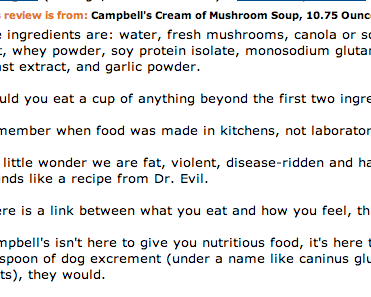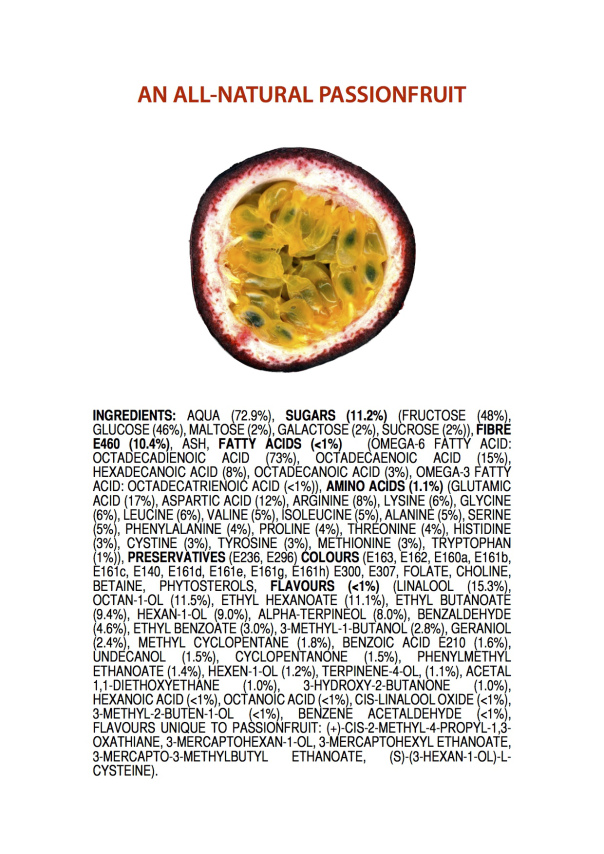Summary: People are cautious about chemicals in their food, overly so. One blogger has been playing with the concept, some. Maybe not completely effectively, but it does bring up some points.
One blogger's attempt to allay chemophobia when it comes to food
BLOT: (20 Jan 2014 - 08:42:40 AM)
One blogger's attempt to allay chemophobia when it comes to food

People are scared of chemicals in their food. Chemicals. Say it. Think about eating chemicals in your morning cereal. Think about sitting down with your loved ones, your children, your best friends, and so forth, and feeding them chemicals. The kind of stuff that they put into bombs and play about with in test-tubes; that they inject people with in movies, forchrissakes! One Amazon reviewer, fist-pounding in rage over the new so-called food we all eat and why Cream of Mushroom soup is the poster-child of factory-produced-fatuousness, has this to say:
Would you eat a cup of anything beyond the first two ingredients? Remember when food was made in kitchens, not laboratories? It's little wonder we are fat, violent, disease-ridden and have difficulties concentrating when the "food" we are given sounds like a recipe from Dr. Evil...
Buy this product if you are lazy, or think that ingestion of suspicious chemicals is the same as nutrition. Or if you have a death wish.
What are these horrendous chemicals that the reviewer is so incensed about? "Water, fresh mushrooms, canola or soybean oil, enriched wheat flour, fresh cream, corn starch, salt, whey powder, soy protein isolate, monosodium glutamate, tomato paste, calcium caseinate (a milk protein), spice, yeast extract, and garlic powder." Even the obvious baddies on that list—protein isolate and MSG and calcium caseinate—are all three naturally occurring things that have been isolated. Yes, even MSG.
Michael Pollan is one of the many who adds to this problematic concept, these fires of needless chemophobia, with rules like "eat foods with fewer ingredients on the label" or "If it's a plant, eat it. If it was made in a plant, don't." But then, this is byproduct of living in a world where grapefruit's polyphenolic compounds can interact with medications in a potentially lethal way, but receive no labeling, while things like "cream" and "canola oil" and "ascorbic acid" and "Carboxymethyl cellulose" do get dinged, despite being all generally harmless. Because the USDA/FDA/et al requires us to label some things and not other things, and the definitions of some things sound terrifying while others sound pure, and that's a really bad way to run things, on how they sound. Beer production has more chemical byproducts and reactions than your average packaged sweet, but I bet it would pass the Pollan test a lot faster.
Stuff like this is why I chuckled while reading io9's coverage of James Kennedy's breakdown of the chemicals of food. Kennedy—identified at io9 as being a chemistry teacher but on his blog as being a grad student in education—has made a series of posters that show the ingredients of "real food". See passionfruit, below, and happy eating...
OTHER BLOTS THIS MONTH: January 2014
dickens of a blog




Written by Doug Bolden
For those wishing to get in touch, you can contact me in a number of ways

This work is licensed under a Creative Commons Attribution-ShareAlike 3.0 Unported License.
The longer, fuller version of this text can be found on my FAQ: "Can I Use Something I Found on the Site?".
"The hidden is greater than the seen."


